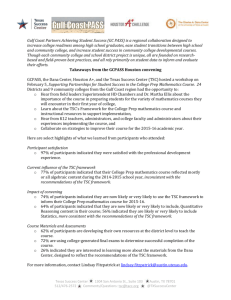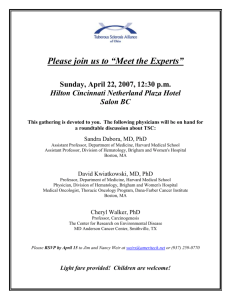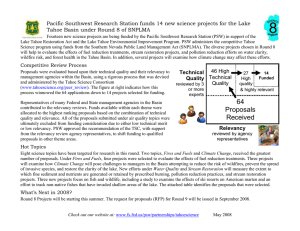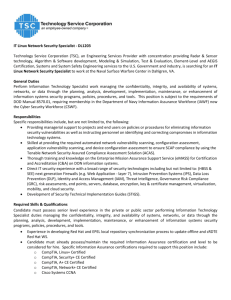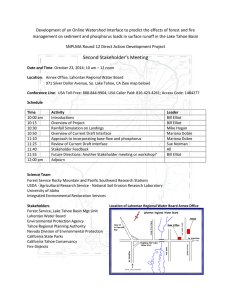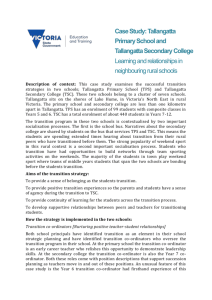TAHOE SCIENCE CONSORTIUM WORK PLAN Management Act (Lake Tahoe science funding)
advertisement
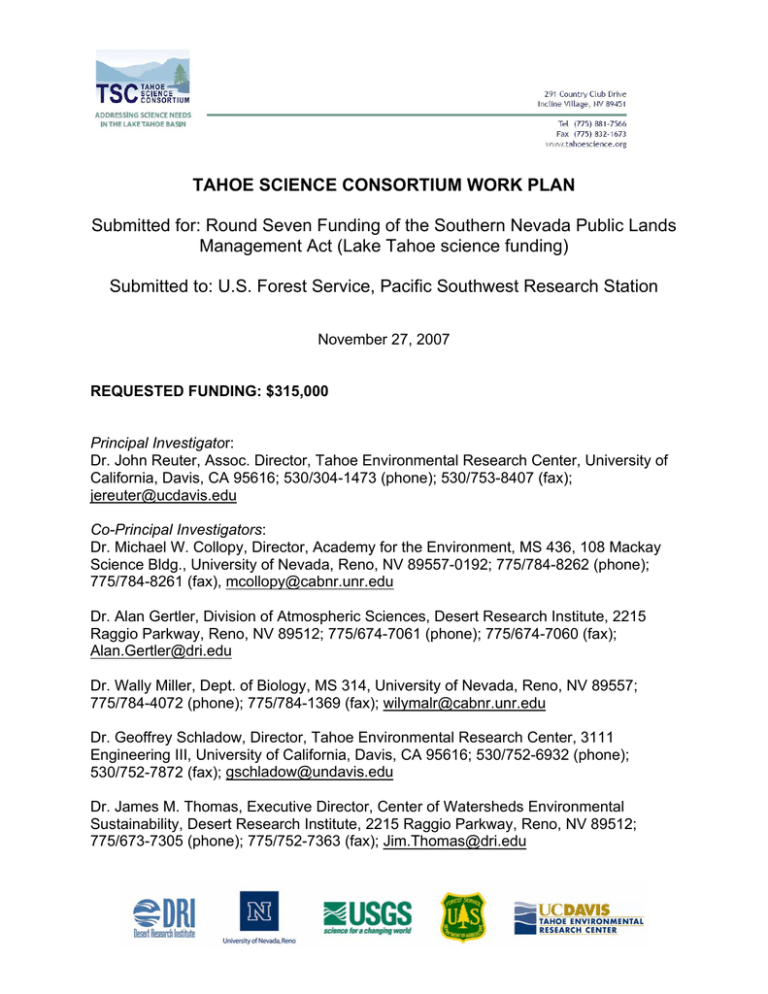
TAHOE SCIENCE CONSORTIUM WORK PLAN Submitted for: Round Seven Funding of the Southern Nevada Public Lands Management Act (Lake Tahoe science funding) Submitted to: U.S. Forest Service, Pacific Southwest Research Station November 27, 2007 REQUESTED FUNDING: $315,000 Principal Investigator: Dr. John Reuter, Assoc. Director, Tahoe Environmental Research Center, University of California, Davis, CA 95616; 530/304-1473 (phone); 530/753-8407 (fax); jereuter@ucdavis.edu Co-Principal Investigators: Dr. Michael W. Collopy, Director, Academy for the Environment, MS 436, 108 Mackay Science Bldg., University of Nevada, Reno, NV 89557-0192; 775/784-8262 (phone); 775/784-8261 (fax), mcollopy@cabnr.unr.edu Dr. Alan Gertler, Division of Atmospheric Sciences, Desert Research Institute, 2215 Raggio Parkway, Reno, NV 89512; 775/674-7061 (phone); 775/674-7060 (fax); Alan.Gertler@dri.edu Dr. Wally Miller, Dept. of Biology, MS 314, University of Nevada, Reno, NV 89557; 775/784-4072 (phone); 775/784-1369 (fax); wilymalr@cabnr.unr.edu Dr. Geoffrey Schladow, Director, Tahoe Environmental Research Center, 3111 Engineering III, University of California, Davis, CA 95616; 530/752-6932 (phone); 530/752-7872 (fax); gschladow@undavis.edu Dr. James M. Thomas, Executive Director, Center of Watersheds Environmental Sustainability, Desert Research Institute, 2215 Raggio Parkway, Reno, NV 89512; 775/673-7305 (phone); 775/752-7363 (fax); Jim.Thomas@dri.edu Introduction and Background In support of a common desire to preserve, restore, and enhance the unique environmental values of the Tahoe basin, federal, state and local resource management/planning agencies and research institutions frequently partner in sciencebased planning and decision making. Collectively, these groups recognize that scientific inquiry, resource assessment, and interpretation of available data are critical to the development and implementation of environmental policy. Additionally, these groups recognize that use of the best available scientific information is required by resource managers to establish environmental standards for water and air quality, soil conservation, wildlife, fish, and vegetation communities, as well as noise and scenic conditions, and recreation opportunities in the Tahoe basin. Since an initial MOU was signed in 1999 –pledging greater collaboration among the research institutions working in the Tahoe basin– the relationship between the scientific community and the management agencies/decision-makers has grown substantially. The formation of the Lake Tahoe Science Advisory Group (SAG) in 2000 helped foster this relationship; however, it was recognized that a more formal organization with financial resources and increased institutional commitment from both research entities and management agencies was required. On August 20, 2005, thirteen executives from academia, state government (Nevada and California) and the federal government signed an MOU that pledged cooperation towards the formation and operation of the Tahoe Science Consortium (TSC) 1 . The purpose of the TSC is to contribute to the restoration of Lake Tahoe, its watershed, and its air basin by providing timely scientific information of direct relevance to natural resources management and land management in the basin. Substantial gaps exist in our current understanding of environmental processes in the Lake Tahoe basin, and a unified and collaborative research effort can provide the most efficient path to restoring and maintaining the multiple components of the basin’s complex ecosystems. Environmental management depends on reliable science efforts that are carried out in an applied and integrative manner. Numerous institutions are actively involved in research, modeling, and monitoring in the Tahoe basin, and it is a primary objective of the TSC to provide environmental managers and decision-makers with the most comprehensive and well-synthesized advice that can be drawn from those endeavors. The TSC is working to accomplish this objective by: 1 • Promoting integration among the many current and future scientific projects in the basin. • Developing processes in collaboration with management agency representatives that provide for ongoing communication between the scientific community and resource management agencies. • Developing a science plan for the Lake Tahoe Basin. The TSC MOU is available at www.tahoescience.org 2 • Developing and administering an independent peer review process for science proposals and products. • Developing a sustainable organizational framework and governance structure for the TSC. The University of Nevada-Reno (UNR), the University of California-Davis (UCD), the Desert Research Institute (DRI), the US Geological Survey (USGS) and the USFSPacific Southwest Research Station (PSW) have all demonstrated a longstanding commitment to research, monitoring and the application of science to management and policy at Lake Tahoe. UNR, UCD and DRI have joined as partners in the submittal of this proposed work plan. As primary collaborators, the USGS and PSW will be included as active participants and equal partners in all TSC discussions and work products. The working structure of the TSC includes: (a) an Executive Committee composed of executive administrators from the five research institutions that provides strategic guidance and leadership; (b) a Committee of Scientists (COS) that is responsible for facilitating the goals of the Consortium; (c) a Director and staff (program coordinator) who work with the COS to fulfill TSC commitments, produce products, and facilitate coordination between the TSC and resource management agencies; and (d) the Science Community, which is open to all researchers with interests and activities in the Tahoe basin. The TSC also nominates a science and research representative to serve on the Lake Tahoe Federal Advisory Committee. As proposed in this work plan, the four focused areas of effort for the third year of TSC operations would include: 1) Science Planning: Continue to work with Lake Tahoe basin agencies to develop regional monitoring approaches for specific issue areas. These efforts will contribute to the larger goal of establishing a comprehensive monitoring strategy for Lake Tahoe basin resources, habitats, and the agents of change. 2) Peer Review: Administering the scientific peer review of research proposals, science products, or technical programs related to Lake Tahoe basin management and restoration. 3) Technical Assistance: Providing scientific input and technical advice to resource management agencies, including organization of one or more public workshops that target challenging resource management issues. 4) Program Management: Managing the day-to-day operations and communications of the TSC including interactions with the Federal Interagency Partnership and the Lake Tahoe Federal Advisory Committee. Preparing progress reports as required by SNPLMA/BLM reporting conditions. These tasks with their associated timelines and deliverables are discussed in more detail below. The successful accomplishment of the tasks described in this proposal requires the maintenance of a modest infrastructure to organize and facilitate all TSC activities. This work plan proposes to continue funding an executive director who will oversee the TSC’s day-to-day operations and serve as a strategic planner in collaboration with the 3 TSC Committee of Scientists (COS) and Executive Committee. The executive director will lead tasks such as convening regular and special meetings of the COS and Executive Committee; maintaining the TSC organizational and governance structure; conducting outreach; working with researchers to engage the Science Community and facilitating the interaction between science and management through jointly defined processes for ongoing communication and interaction; managing work plan tasks and product delivery; and organizing/managing the independent scientific review activities and technical workshops. The work plan also proposes to continue funding a half-time program coordinator who will assist the executive director in fulfilling his responsibilities. Science Planning: Continue develop of regional monitoring plans Background Science planning will continue to play an important role in the environmental management of Lake Tahoe, its watershed, and its air basin. In 2006 the TSC initiated development of a comprehensive science plan for the Lake Tahoe Basin. 2 This plan provides a framework and strategy for the science activities that together comprise a comprehensive science program. In addition, the science plan includes focused research strategies for the issue areas of water quality (including storm water BMP’s), air quality, ecology and biodiversity (including vegetation management), soil conservation, social sciences, and natural hazards. Guiding science investments over the next five - ten years is an important function of the science plan. In 2007 the TSC shifted its science planning focus to the development of regional monitoring plans, with the ultimate goal of working with agency representatives to develop a comprehensive monitoring program for the Lake Tahoe Basin. Initial efforts focused on the creation of a framework for the development of conceptual models, as well as the development of a regional monitoring plan for storm water quality and BMP retrofit projects. This topic area was chosen based on an expression of interest from implementing and regulatory agencies. Project Goals/Objectives The goal of this task is to continue the development of issue specific regional monitoring plans that support the larger goal of developing a comprehensive monitoring program for the Lake Tahoe Basin. Specifically, efforts under this task would focus on the development of more detailed descriptions and recommendations for the science activities of: (a) status and trends monitoring, (b) project/program performance monitoring, (c) data and information management, and (d) data assimilation, synthesis, and information communication. These efforts would be pursued for specific topic area(s) to be chosen in collaboration with Lake Tahoe resource management and regulatory agencies. Work by the TSC to develop regional monitoring plans will require collaboration and interaction with agencies representatives to identify management goals and objectives. 2 The Comprehensive Science Plan for the Lake Tahoe Basin is available at http://www.tahoescience.org/tsc_products/Products.aspx. 4 In addition, several agencies have funded projects aimed at producing monitoring plans for some program areas, and working collaboratively we hope to integrate these efforts. For example, TRPA is beginning work to develop monitoring plans for threshold indicators in collaboration with Pathway planning agencies (USFS, NDEP, and LRWQCB). This monitoring program will be used to assess the status of various threshold indicators and provide the data necessary for periodic threshold assessments. These activities should produce products of relevance to both regional monitoring plans and a comprehensive monitoring program for the Lake Tahoe Basin. Work Activities and Products Several steps are necessary to successfully develop topic-specific regional monitoring plans. The major steps include: 1. Continuing discussions among local, state and federal management agencies and the science community regarding the monitoring efforts needed to guide and inform the assessment of restoration activities, the application of adaptive management, and, the status and trends of resources, habitats, and stressors in the Lake Tahoe Basin. Identify the highest priority topic area(s) to pursue for development of regional monitoring plan(s). 2. Recount the steps to develop a regional storm water monitoring plan as a means to help guide the development of other issue-specific regional monitoring plans. 3. Work collaboratively with agency representatives to identify the issue-specific monitoring goals and specific objectives. Use these objectives to identify the resources these agencies expect to apply to various monitoring efforts. 4. Produce a draft of the recommended monitoring plan/approach that provides more detailed guidance and recommendations for the science activities of monitoring, data management, data analysis, information communication and assimilation. 5. Distribute the draft plan to agency representatives, stakeholders, and the science community for review and comment. 6. Revise the draft plan based on the comments received and produce a final plan for public distribution and use. 5 Science Planning Budget Category Domestic Travel Equipment Supplies Cost $1,500 N/A $2,790 Description Travel for this task includes automobile mileage and per diem (lodging, meals, incidental expenses, and indirect costs) for the TSC Executive Director and members of the Science Community who contribute to science planning efforts. N/A It is anticipated that a total of $9,300 (direct and indirect costs) in supplies will be required to support all efforts described in this work plan. This value is apportioned among the tasks, with 30% anticipated to support science planning work. Personnel/Labor Executive Director Program Coordinator Science Community Construction Other Total Cost Science Planning $53,022 $8,664 $41,631 N/A N/A Includes salary, fringe benefits, and indirect costs. The Director will allocate 30% time to this task. He will be responsible for arranging meetings with agency and science representatives, working with the science community to develop regional monitoring plans, produce and distribute interim and final reports, and attend meetings associated with this task. Includes salary, fringe benefits, and indirect costs; 1/2-time for 3 months. Assists TSC Director with project coodination including scheduling meetings, report production, bookkeeping, note taking, preparation of meeting materials, and communication among agency and science representatives. Used to support salaries, fringe benefits, and indirect costs of practicing researchers that participate in or lead discussions, contribute technical information, and write sections of the monitoring plans. (Amount based on an average pay rate of $50/hour and an approximately 416 hours of work.) N/A N/A $107,607 Peer Review: Provide Independent Scientific Peer Review Services Background Independent and unbiased review of both proposed and completed scientific work is a critical component of the scientific process. In complex systems where science activities are undertaken to produce information that reduces uncertainty, addresses gaps in knowledge, and informs decision-makers, independent and unbiased scientific review can be applied at multiple levels: The Proposal Level: The review of proposals for new science is intended to improve the quality of the experimental design associated with the proposed research, monitoring, or adaptive management project. 6 The Project Level: Review of products (e.g., reports and manuscripts) from completed science projects ensures that data analysis and interpretation are appropriate and justified based on the work completed and the results of other relevant studies. The Program Level: Reviews at this level are intended to provide expert advice and ideas about how to develop scientific information that best meets management needs or policy goals, and to provide feedback on the quality of science that underpins program activities. A significant function of the Tahoe Science Consortium (TSC) is to provide the service of independent and unbiased scientific review of science activities or scientific results produced through any of the levels listed above. This peer review is intended to ensure that science activities conducted in the basin, and funded by agencies charged with the management and restoration of the Lake Tahoe basin, are scientifically sound, consistent with the basin’s science plan, compatible with previous research activities, and in compliance with the federal Data Quality Act (Section 515 of Public Law 106554). Independence and lack of bias are the foundation of any credible peer review process. Although scientists from the member organizations of the TSC may be among those who submit research proposals to a request for proposals, the TSC is emphatic that the peer review process it administers will be credible, transparent, independent, and unbiased. This work plan provides funding necessary to allow the TSC to continue providing essential independent peer review services of science activities in the Lake Tahoe basin. Sufficient funding is requested to support TSC-led peer review of the science proposals received in response to the SNPLMA Lake Tahoe science program request for proposal. The TSC will also work with agencies to scope special initiative reviews or project reviews; however, this work plan does not include funding to complete these reviews. The TSC will remain receptive to administering additional reviews if supplementary external funds are provided. Work Activities and Products The peer review process document developed by the TSC 3 will guide the TSC’s peer review activities funded under this work plan. Generally, the work activities and products for this work plan will follow the steps listed below: Peer Review of Science Proposals 1. Work with the sponsoring agency(s) to develop the scope and timeline for the review of SNPLMA science proposals received through a specific RFP. 2. Assemble independent reviewers and administer the review process. 3. Complete a relevancy check with agency representatives. 3 The document describing the TSC peer review processes is available at http://www.tahoescience.org/EventImage.aspx?sa=1&id=110 7 4. Compile and synthesize reviewer’s comments and present results to the sponsoring agency or other entity as appropriate in the form of a prioritized list of project proposals recommended for funding. Expected Benefits The expected benefits are more technically sound science proposals, increased credibility of science products, and increased confidence in the science information used to make management decisions. Peer Review Budget Category Cost Domestic Travel $600 Equipment N/A Supplies $2,790 Description Travel for this task includes automobile mileage, per diem, and indirect costs for members of the TSC Peer Review Committee to attend committee meetings. It is anticipated that a total of $9,300 (direct and indirect costs) in supplies will be required to support all efforts described in this work plan. This value is apportioned among the tasks, with 30% anticipated to support the TSC peer review services. Personnel/Labor Includes salary, fringe benefits, and indirect costs. The Director will allocate 30% time to this task. He will be a member of the PRC and will have lead responsibility for administering all peer reviews undertaken by the TSC. Includes salary, fringe benefits, and indirect costs; 1/2-time for 4 months. Assists TSC Director and Peer Review Committee with the administration of the peer review process including scheduling reviews, contacting potential reviewers, sending out review materials, organizing panel review logistics, compiling review comments, managing the peer review content of the TSC web site, and working with UNR staff to process honoraria requests and bookkeeping. Executive Director $53,022 Program Coordinator $11,436 Peer Review Committee $3,900 Stipend for three science community representatives ($1,300/member) serving on the TSC Peer Review Committee. Peer Reviewers $21,600 Honoraria for technical experts ($18,000) and indirect costs ($3,600) to perform independent peer reviews of science proposals. (Assumes 80 proposals with 3 reviews each (240 reviews total) at a cost of $75/review.) Peer Reviewer Contract Administration $2,592 Includes salary, fringe benefits, and indirect cost for 1/2-month of UNR administrative assistant time to oversee the processing and administration of individual peer reviewer contract agreements. Construction Other TSC Website update and Maintenance Total Cost Peer Review N/A $750 The peer review area of the TSC website is essential to timely and effective implementation of the TSC peer review processes. Update and maintenance of the peer review area will be required so it remains an effective tool to solicit for independent reviewers, distribute review materials to reviewers, post review schedules and review results. $96,691 8 Technical Assistance: Scientific Consultation and Information Transfer The TSC and its scientific resources propose to contribute (as requested) directly to the design, administration, and implementation of resource management programs in the Lake Tahoe basin. TSC technical assistance may include: • Assisting agency staff in the development of adaptive management programs and projects in key resource management issue areas, or in the development of new tools (e.g., conceptual models) important to effective adaptive management. • Cooperating with agencies in the development of effective monitoring schemes, including goal setting, development of conceptual models, indicator selection, sampling design, data analysis, and interpretation of results. • Assisting agencies in translation and evaluation of monitoring results, examination of management practices (where appropriate), and integration of new knowledge into resource management plans. • Providing science information and advice to Lake Tahoe basin land and resource management agencies, participants in the basin’s Environmental Improvement Program, members of the Lake Tahoe Federal Advisory Committee, and interested stakeholders. • Assisting agencies and jurisdictions in the development of the scientific foundation underpinning environmental documents and facilitating scientific review of management documents for scientific rigor. • Providing technical advice in the development of key management and restoration planning efforts, including regional plans (e.g., the Pathway planning process) and the Environmental Improvement Program. • Assisting in prioritization of management and restoration activities for funding and implementation to enhance contributions toward the basin’s planning directives. • Providing technical assistance that leads to the development of recommended science themes and study areas for allocation of the Lake Tahoe SNPLMA science funding. • Providing a technical review of the Lake Tahoe SNPLMA capital project proposals and identifying opportunities to obtain new information. The TSC will provide scientific consultation and information transfer services at the request of resource management agency representatives and established committees. The extent of input and consultation will be limited by available funding, but the TSC will remain receptive to providing additional assistance if supplementary external funds are made available. Completion of a forest management literature review and synthesis papers is one specific technical assistance project the TSC will complete under this work plan. The 9 goal of this effort is to assemble all the recent scientific literature that pertains to Lake Tahoe Basin forest management issues, and to interpret results and findings that could be applicable to management problems in the Basin. This means considering both research that has been conducted in and around the Basin as well as research done elsewhere that could be relevant to Lake Tahoe Basin conditions. A web-based annotated bibliography is being produced using previously received SNPLMA funding. Funding allocated in this work plan will be combined with funding from the USFS Lake Tahoe Basin Management Unit to produce up to five synthesis papers. We anticipate the lead authors will submit these papers to professional journals for publication. Knowledge transfer from the TSC to other agencies and the public also will be accomplished through the TSC website. This website is an important tool for information dissemination to make people aware of TSC activities and other science activities occurring throughout the Lake Tahoe Basin. The website will include information on research programs currently being performed in the basin, summaries of current and past studies, and links to information about agency, research institutions, and individual researcher activities. The TSC proposes to organize one or more workshops to discuss technical issues associated with some of the more challenging management issues facing the Lake Tahoe Basin. The exact topics of these workshops will be determined in consultation with resource management agency representatives, but example topics include, methods for accomplishing forest fuel reduction in stream environment zones, or identifying information needs to develop quantitative water quality standards for the near shore zone of Lake Tahoe. These workshops will focus on clarifying the state of knowledge, resolving conflicts in understanding, and reducing uncertainty. The workshops will typically last one day and may include presenters from inside and outside the Lake Tahoe basin. Written summaries of information and outcomes from each technical workshop will be posted on the TSC web page. 10 Technical Assistance Budget Category Domestic Travel Equipment Supplies Cost $1,400 Description Travel for this task includes automobile mileage, per diem, and indirect costs for the TSC Executive Director and members of the Committee of Scientists to attend meetings and communicate with agency representatives. These funds may also be used to cover travel costs of outside researchers invited to participate in the technical workshops N/A $1,860 It is anticipated that a total of $9,300 (direct and indirect costs) in supplies will be required to support all efforts described in this work plan. This value is apportioned among the tasks, with 20% anticipated to support scientific consultation and information transfer efforts. Personnel/Labor Executive Director $44,185 Program Coordinator $5,892 Science Community $19,000 Construction Other N/A TSC Website support $750 Total Cost Technical Assistance Includes fringe benefits and indirect costs. Director will allocate 25% time to this task. He will be the TSC point of contact for agency technical assistance requests; arranging, and tracking meetings with agencies and TSC representatives; TSC representative attending agency management meetings; work with the admin. assistant and COS to maintain website contents; convene regular TSC meetings; liaison with TSC Board; and lead efforts to organize one or more technical workshops. Includes salary, fringe benefits, and indirect costs; 1/2-time for 2 month. Assists TSC Executive Director in assembling information needed to produce required reports or presentations, maintaining the content of the TSC website, organizing and documenting meetings, and ensuring effective communication among interested parties. Used to support salaries, fringe benefits, and indirect costs of practicing researchers that: 1) lead the development of forest management literature review synthesis papers ($15,000). And 2) participate in discussions, contribute technical information, and contribute to writing of white papers, workshop summaries, or other documents as needed to support technical assistance efforts ($4,000). (Amount based on an average pay rate of $50/hour and an approximately 190 hours of work.) Used to support the update, maintenance, and capabilities expansion of the TSC website to ensure it remains an effective technical assistance tool. $73,087 11 Program Management Management of the TSC operations and functions, its programs, and activities is a primary responsibility of the Executive Director and Program Coordinator. Program management includes ongoing communication of TSC activities. These activities include convening regular meetings of the COS and TSC staff; meeting with the Executive Committee, supporting TSC participation in various agency committees (e.g., TSACC, TIE, and LTFAC); and the preparation and distribution of TSC information materials via presentations, the TSC website, or written materials. The TSC will provide quarterly reports of its progress on the tasks described in this work plan. The schedule for submission of these reports will be set by the PSW. Specifically, these reports will summarize activities and accomplishments on the development of regional monitoring plans for the Lake Tahoe basin, implementation of the peer review process, and scientific consultation and information transfer. Program Management Budget Category Cost Domestic Travel $580 Equipment N/A Supplies $1,860 Description Travel for this task includes automobile mileage, per diem, and indirect costs for both the TSC Executive Director and the Program Coordinator to attend meetings necessary to obtain information for grant reporting and to communicate TSC activities and progress to agency, stakeholder, and science community representatives. N/A It is anticipated that a total of $9,300 (direct and indirect costs) in supplies will be required to support all efforts described in this work plan. This value is apportioned among the tasks, with 20% anticipated to support program management efforts. Personnel/Labor Executive Director $26,511 Program Coordinator $8,664 Construction Other Total Cost Technical Assistance N/A N/A Includes fringe benefits and indirect costs. Director will allocate 15% time to this task. This includes attending and leading meetings with TSC representatives; representing the TSC at agency and stakeholder meetings; working with the admin. assistant and COS to maintain website content; preparing quarterly progress reports; and leading or co-leading efforts to organize one or more technical workshops. Includes salary, fringe benefits, and indirect costs; 1/2-time for 3 month. Assists TSC Executive Director in assembling information needed to produce required reports or presentations, maintaining the content of the TSC website, organizing and documenting meetings, and support for TSC communication and reporting efforts. N/A N/A $37,615 12
